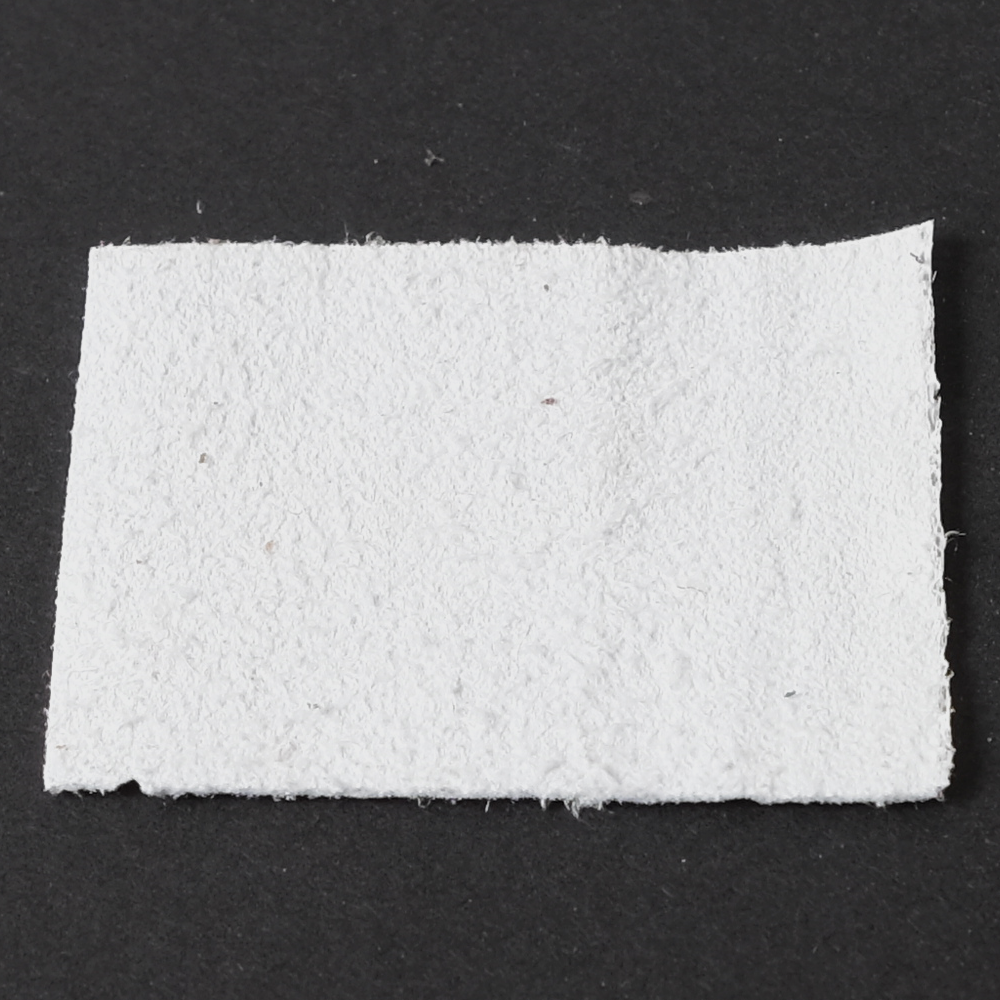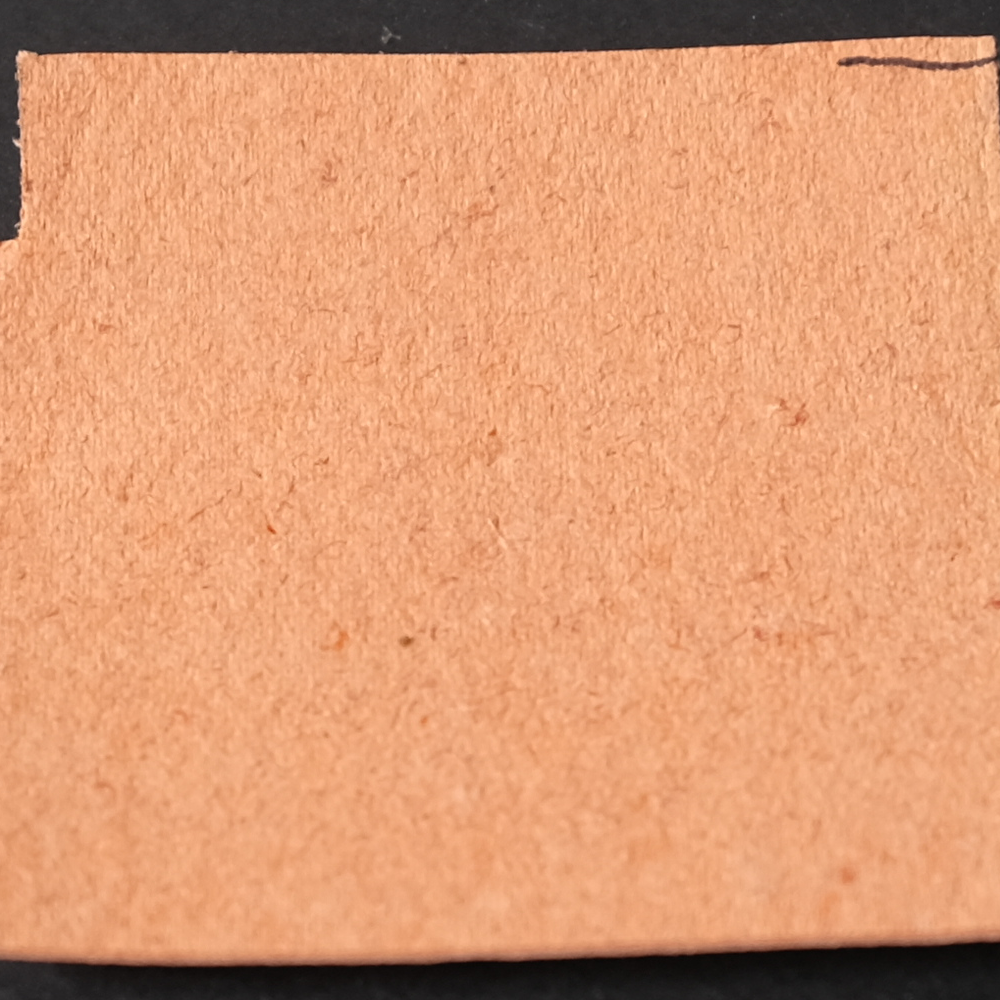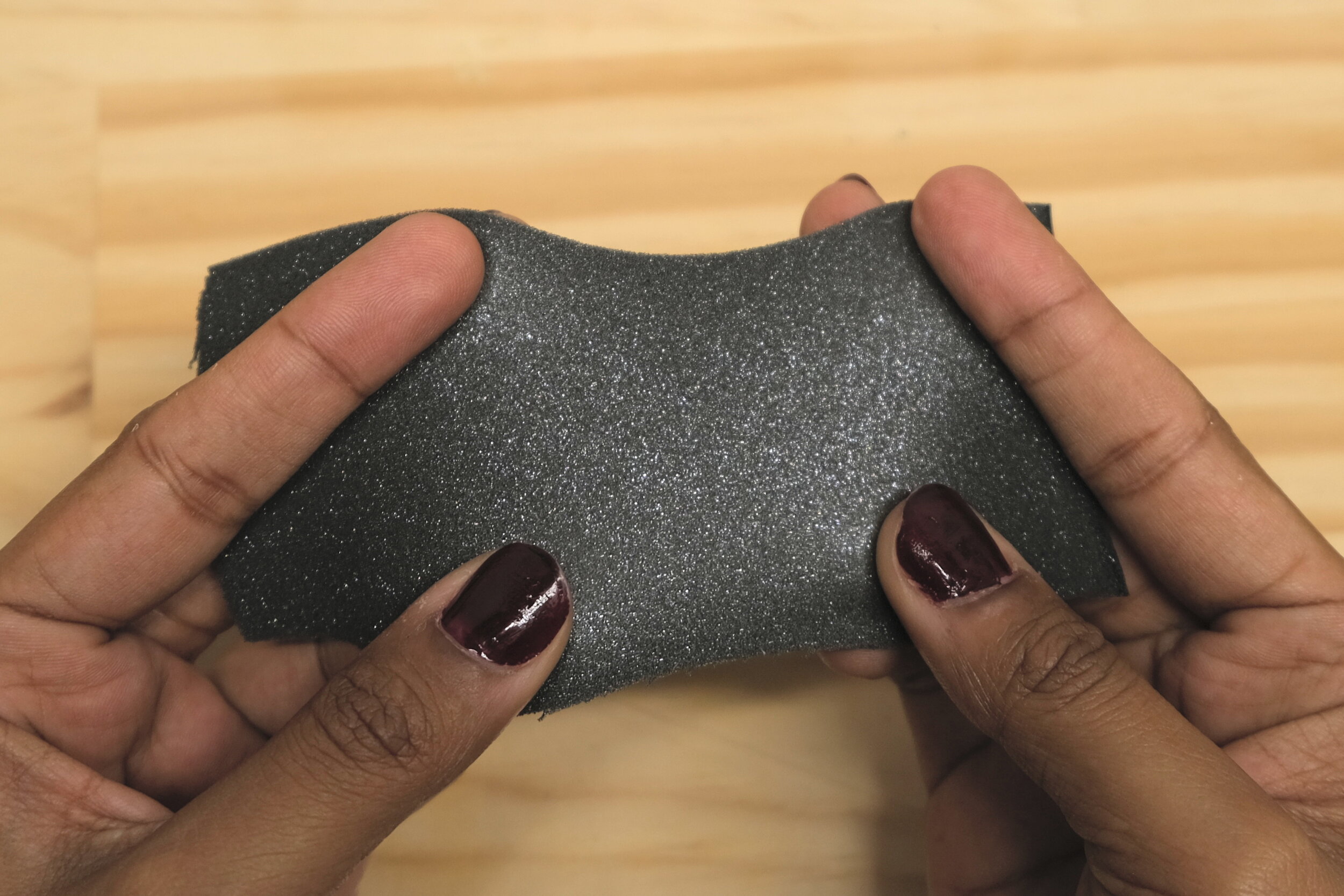Update 29/12/21: Added Velodon and Saba experiment results
I wanted to understand how reinforcements work and what makes them better for some use cases over others, and why. The best way to do so was to conduct a few experiments to get first-hand experience with these materials.
As a control, I used normal printer paper. The reinforcement materials I experimented with were Oslo (2mm), Microfibra (0.5mm, 1mm), Brio (0.7mm), Salpa (0.6mm), Velodon 0.2mm, and Saba (2mm).
Oslo (2mm)
Microfibra (0.5mm)
Microfibra (1mm)
Brio (0.7mm)
Salpa (0.6mm)
Method
I set up a set of simple experiments to get a feel for each material.
Hand ripping: This involved tearing the material vertically, like you would a piece of paper
Force tear: This involved pulling on the material in opposite directions to break it. Force was measured coarsely in light, medium, and strong scale based on my personal strength
Stretch: This assessed if the material had any stretch, and in which direction
Cut effort: A box cutter was used to cut the material and I assessed how easy or difficult it was to cut through and to cut straight
Skive: Using a bell skiver I attempted to skive the material to half its thickness
Fold: I folded the material and then straightened it. The aim was to see if bending it completely double would leave a crease
Bend: I clipped two edges together and left the material in a bent position for a few days. The aim was to assess how quickly the material would spring back to its original shape, or if it would retain a fully or partially bent form
Glue: I wanted to see how well the material would accept glue, and if it absorbed the glue more so than leather. Glue used was Duall 88, an all purpose contact cement (solvent-based), Renia Aquilim 315, and Seiwa leather adhesive
Burnish: After gluing two pieces of leather with reinforcement between them, I wanted to see how well an exposed reinforcement edge would take to burnishing. Both edges of leather were beveled, the edge then water-burnished with an edge slicker
Edge paint: After gluing two pieces of leather with reinforcement between them, I wanted to see how well an exposed reinforcement edge would take to edge paint. I used Fenice primer, heated, then Fenice edge paint 3 layers, sanding with 600 grit in between layers
Double layer full bond stiffness: I wanted to assess the stiffness added by glue when two layers of reinforcement were glued together. I chose to bond two reinforcement layers rather than a layer of reinforcement and one of leather because leather type varies greatly in temper. Flexibility was measured by feel: x1 is how two unbonded layers feel; x2 is twice the stiffness magnitude, and so on.
Double layer full bond with weight: I wanted to compare the effect of applying a weight overnight on the bond and stiffness (final temper) of the two reinforcement layers. For this I put the bonded material on the table with a glass plate on top, and a weight on top of that overnight. Flexibility was measured by feel: x1 is how two unbonded layers feel; x2 is twice the stiffness magnitude, and so on.
Double layer partial bond stiffness: I wanted to compare stiffness of a partially bonded reinforcement material (only the edges glued) to fully bonded. Flexibility was measured by feel: x1 is how two unbonded layers feel; x2 is twice the stiffness magnitude, and so on.
Wet ripping: Tearing vertically after material has been in water for 30 seconds
Wet tearing: Force tearing after material has been in water for 30 seconds
Soak: Effect of soaking the material in water for 1 hour
Results
Outlined below are the results of each experiment grouped by material.
The video below shows the results of the Bend experiment. Materials from left to right are: Oslo (2mm), Microfibra (0.5mm), Microfibra (1mm), Brio (0.7mm), and Salpa (0.6mm).
Paper (control)
Hand ripping: Easy to rip
Force tear: Easy to tear by pulling it apart
Stretch: No stretch
Cut effort: Easy to cut
Skive: Too thin to skive successfully
Fold: When folded leaves a distinct crease
Bend: When held bent for a long time stays curled
Glue: Takes all the glues without issue, but the water-soluble glues (aquilim and seiwa) leave ripples in the paper when dry
Burnish: Does not burnish
Edge paint: Edge can be painted
Double layer full bond stiffness: x3
Double layer full bond with weight: x3
Double layer partial bond stiffness: x2.5, leaves an air bubble in the middle
Wet ripping: Easier to rip than when dry
Wet tearing: Easier to tear apart than when dry
Soak: Loses form and turns into a pulpy mess and falls apart
Oslo (2mm)
Hand ripping: Easy to rip
Force tear: Easy to tear by pulling apart
Stretch: Great deal of stretch in all directions
Cut effort: Stretchy so difficult to cut precisely with a box cutter. I’d have better luck with a rotary knife or a pair of scissors
Skive: No issues with skiving
Fold: When folded doesn’t leave a crease
Bend: After held in a bent position for a few days immediately springs back with no curl
Glue: Takes all the glues, but its stretchy nature makes it a bit difficult as the material can warp slightly during application. It soaks up Aquilim and Seiwa a bit
Burnish: Does not burnish
Edge paint: Does not edge paint. This is basically sponge and just soaks up the paint
Double layer full bond stiffness: x3
Double layer full bond with weight: x3
Double layer partial bond stiffness: x2
Wet ripping: Easy to rip
Wet tearing: Easy to tear by pulling apart
Soak: Easier to rip and tear after a soak
Oslo (2mm) stretch
Oslo (2mm) skive
Oslo (2mm) fold
Oslo (2mm) glue
Oslo (2mm) edge paint
Microfibra (0.5mm)
Hand ripping: Too hard to rip by hand
Force tear: Too hard to tear by pulling it apart by hand
Stretch: Slight stretch one way
Cut effort: Somewhat stretchy so makes it annoying to cut in the stretch direction
Skive: Risky to skive this thin
Fold: Does not take a crease when folded in half
Bend: When held in a bent position for a few days immediately springs back to its original position
Glue: Takes all the glues without issue
Burnish: Does not burnish
Edge paint: Can be edge painted
Double layer full bond stiffness: x3
Double layer full bond with weight: x3
Double layer partial bond stiffness: x2, leaves an air bubble in the middle when folded
Wet ripping: Too hard to rip by hand
Wet tearing: Too hard to tear by pulling it apart by hand
Soak: Too hard to rip or tear after a soak
Microfibra (0.5mm) stretch
Microfibra (0.5mm) skive
Microfibra (0.5mm) glue
Microfibra (0.5mm) edge paint
Microfibra (1mm)
Hand ripping: Too hard to rip by hand
Force tear: Too hard to tear by pulling it apart by hand
Stretch: Slight stretch one way
Cut effort: Somewhat stretchy so makes it annoying to cut in the stretch direction
Skive: No issue with skiving to half thickness
Fold: Takes a slight crease when folded in half
Bend: When held in a bent position over a few days remains almost completely bent
Glue: Takes all the glues without issue
Burnish: Does not burnish
Edge paint: Can be edge painted
Double layer full bond stiffness: x4
Double layer full bond with weight: x4
Double layer partial bond stiffness: x3
Wet ripping: Too hard to rip by hand
Wet tearing: Too hard to tear by pulling it apart by hand
Soak: Too hard to rip or tear after a soak
Microfibra (1mm) stretch
Microfibra (1mm) skive
Microfibra (1mm) fold
Microfibra (1mm) glue
Microfibra (1mm) edge paint
Brio (0.7mm)
Hand ripping: Too hard to rip by hand
Force tear: Too hard to tear by pulling it apart by hand
Stretch: No stretch
Cut effort: Stiff, but easy enough to cut with a sharp blade
Skive: Skives fine, but be careful, its stiffness may cause the skived layer to gum up the machine
Fold: When bent in half the crease very distinctly remains
Bend: When held in a bent position for a few days stays slightly bent
Glue: Takes all the glues without issue
Burnish: Does not burnish
Edge paint: Can be edge painted, but leaves a slight ridge
Double layer full bond stiffness: x4
Double layer full bond with weight: x4
Double layer partial bond stiffness: x3
Wet ripping: Too hard to rip by hand
Wet tearing: Too hard to tear by pulling it apart by hand
Soak: Too hard to rip or tear after a soak
Brio (0.7mm) fold
Brio (0.7mm) skive
Brio (0.7mm) glue
Brio (0.7mm) edge paint
Salpa (0.6mm)
Hand ripping: Relatively easy to rip
Force tear: Too hard to tear by pulling it apart by hand
Stretch: No stretch
Cut effort: Easy to cut with a box cutter
Skive: Easy to skive
Fold: When folded in half leaves a distinct crease
Bend: When held in a bent shape stays mostly bend
Glue: Takes all the glues without issue
Burnish: Does not burnish
Edge paint: Can be edge painted
Double layer full bond stiffness: x5
Double layer full bond with weight: x5
Double layer partial bond stiffness: x4
Wet ripping: Easier to rip than when dry
Wet tearing: Too hard to tear by pulling it apart by hand
Soak: Easy to rip, but too hard to tear after a soak
Salpa (0.6mm) fold
Salpa (0.6mm) skive
Salpa (0.6mm) edge paint
Velodon (0.2mm)
Hand ripping: Too hard to rip by hand, but does distort
Force tear: Too hard to tear by pulling it apart by hand
Stretch: No stretch
Cut effort: Easy to cut with a box cutter
Skive: Too thin to skive successfully
Fold: When folded leaves a distinct crease
Bend: Holds some bend after 48 hrs
Glue: Takes all the glues without issue, surprisingly, including Aquilim
Burnish: Does not burnish
Edge paint: Edge can be painted
Double layer full bond stiffness: x4 (part of this I think is coming from a coating of adhesive this velodon had)
Double layer full bond with weight: x4
Double layer partial bond stiffness: x2
Wet ripping: Too hard to rip by hand
Wet tearing: Too hard to tear by pulling it apart by hand
Soak: Too hard to rip or tear after a soak
Saba (2mm)
Hand ripping: Easy to rip
Force tear: Easy to tear by pulling apart
Stretch: Great deal of stretch in all directions
Cut effort: Easy to cut with a box cutter, but distorts a bit, so a rotary cutter is better suited
Skive: Doesn’t skive very well at all, the compression and immediate spring back doesn’t make it easy. I think if I were to bond the saba to another backing like leather, and skived both of those together it might be a bit easier
Fold: Does not leave a crease, and springs right back
Bend: Almost goes back to its original shape, but not quite
Glue: I ran out of Dual88, so only used Aquilim 315 and Seiwa glues. It takes glue just fine, but unlike Oslo the glue doesn’t seep in. This substance is a little like neoprene
Burnish: Does not burnish
Edge paint: Takes paint, but leaves a ridge in between. Best not to take the reinforcement all the way to the edge
Double layer full bond stiffness: x3
Double layer full bond with weight: x3
Double layer partial bond stiffness:
Wet ripping: Easy to rip
Wet tearing: Easy to tear by pulling apart
Soak: Just as easy to rip and tear, soaking didn’t have much of an effect
Conclusion
Edge burnishing when reinforcement is in use would best be done if the reinforced material is completely enclosed in leather, i.e. ensure that reinforcement layer doesn’t reach the edge or by skiving to feather thinness so there is no substance at the edge.
Edge painting, although works with almost all the reinforcement materials, remains a visible layer after two thin coats. To eliminate this issue entirely I think not dealing with the reinforcement material reaching the edge would be a better solution.
Oslo (2mm): This rather spongy substance would work well for a cushiony padded look intended to fill out the volume between the leather layers. It has a slight memory foam feel and holds a squish for a few seconds.
Microfibra (0.5mm): This thickness of microfibra would give a little bit of support to a leather of a similar thickness, e.g. wallet pockets. I’d be curious to see how this thickness would work when a layer is bonded to the main body leather and another layer to the liner for bags.
Microfibra (1mm): This is a good thickness for thin floppy leathers. Ideal usage would be for bag flaps or body, notebook covers, something that will stay in somewhat the same shape through its life.
Brio (0.7mm): The stiffness of this material restricts the uses this material could have. A sturdy bag base comes to mind, or a stiff bag body of a suitcase-style bag would be two use cases I can think of for this.
Salpa (0.6mm): This particle board equivalent of leather reinforcement is pretty versatile in its uses I think, but I question its durability. I would have no issues using it for the cover or backing on a padfolio, but I wouldn’t use it on anything that bends all the time, like watch straps, or belt lining.
Velodon (0.2mm): The thinness and non-stretchy nature of this material lends itself well to being used in watch straps where you don’t want thin leather to stretch over time. It has also been used as pocket material for tranche pockets. Where non-stretch material is required in large areas that non-stretch woven tape is too thin for, I think Velodon might work as a substitute. It has been known to react poorly to PVA type glues like Aquilim315 (despite my finding no evidence of this). An adhesive-backed version can be found at Rocky Mountain, so to avoid all glue issues you could simply use that.
Saba (2mm): This squishy material is ideal for padding effect. Its function is a lot like Oslo, but without the minor memory foam effect
What’s next?
Some more experiments will follow these simple ones. I’ll be focusing on how turned items behave with each of the materials, and the effects of fully and partially bonding the reinforcement to both the body leather and the liner on the overall look and feel.



























